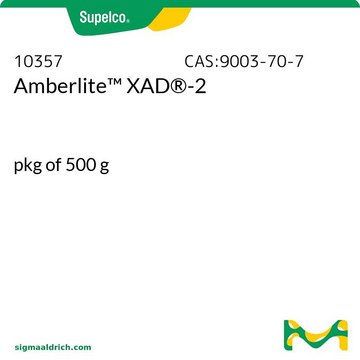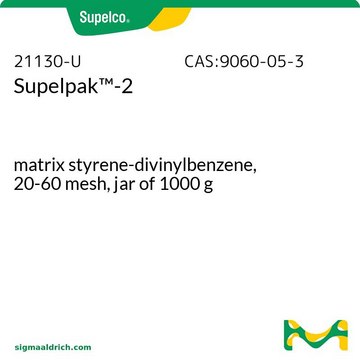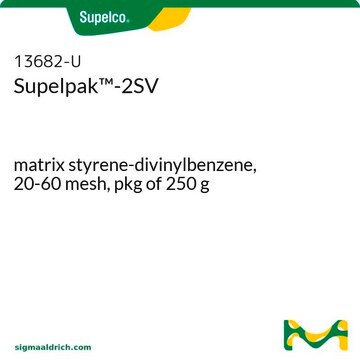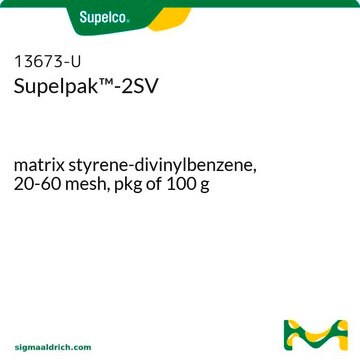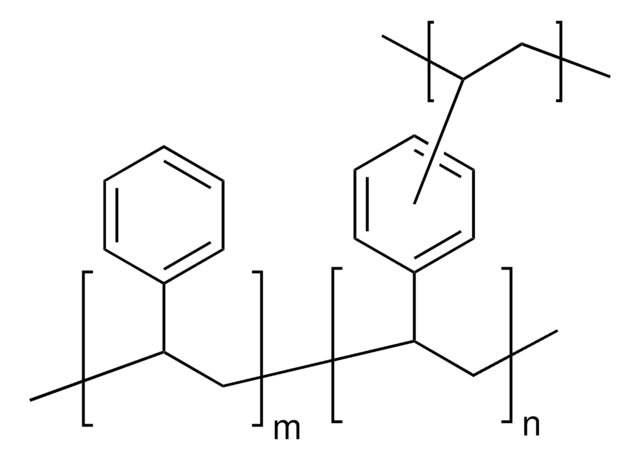13674-U
Supelpak™-2SV polymeric adsorbent
matrix styrene-divinylbenzene, 20-60 mesh, pkg of 1000g
Synonym(s):
xad-2
Sign Into View Organizational & Contract Pricing
All Photos(1)
About This Item
UNSPSC Code:
23151817
NACRES:
SB.52
Recommended Products
Product Name
Supelpak™-2SV, matrix styrene-divinylbenzene, 20-60 mesh, pkg of 1000 g
form
beads
Quality Level
packaging
pkg of 1000 g
technique(s)
LPLC: suitable
surface area
~300 m2/g
matrix
styrene-divinylbenzene
matrix active group
polymer
particle size
20-60 mesh
pore size
~0.65 mL/g pore volume
90 Å mean pore size
application(s)
environmental
separation technique
reversed phase
Looking for similar products? Visit Product Comparison Guide
General description
Supelpak™-2SV is purified Amberlite™ XAD2 that has been specially cleaned and tested for optimal performance in the capturing and extraction of semivolatile organics. Packaged in glass containers.
Application
- Supelpak™-2SV resin was used as column packing material to extract sesquiterpenes.
- Supelpak™-2SV resin was used in glass column as packing material to capture limonene.
- Supelpak™-2SV resin was used as packing material to capture the off gas for NMR analysis.
Legal Information
Amberlite is a trademark of DuPont de Nemours, Inc.
Supelpak is a trademark of Sigma-Aldrich Co. LLC
Storage Class Code
11 - Combustible Solids
WGK
WGK 3
Flash Point(F)
Not applicable
Flash Point(C)
Not applicable
Choose from one of the most recent versions:
Already Own This Product?
Find documentation for the products that you have recently purchased in the Document Library.
Engineering cyanobacteria for the production of a cyclic hydrocarbon fuel from CO2 and H2O
Halfmann, Charles, Liping Gu, and Ruanbao Zhou
Green Chemistry, 16, 3175-3185 (2014)
Sean A Agger et al.
Journal of bacteriology, 190(18), 6084-6096 (2008-07-29)
Cyanobacteria are a rich source of natural products and are known to produce terpenoids. These bacteria are the major source of the musty-smelling terpenes geosmin and 2-methylisoborneol, which are found in many natural water supplies; however, no terpene synthases have
Grayson T Wawrzyn et al.
Methods in enzymology, 515, 83-105 (2012-09-25)
Fungi produce a myriad of terpenoids with a broad range of biological activities, many of which can be adapted to human use. This requires knowledge of the enzymes responsible for the biosynthesis of these compounds. Herein, we describe strategies for
Our team of scientists has experience in all areas of research including Life Science, Material Science, Chemical Synthesis, Chromatography, Analytical and many others.
Contact Technical Service